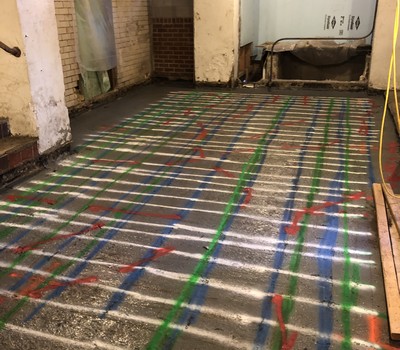Discover RainierGPR Service Areas Near You for Specialist Concrete Scanning
Discover RainierGPR Service Areas Near You for Specialist Concrete Scanning
Blog Article
Enhancing Project Preparation and Execution Through Advanced Concrete Scanning Strategies
In the realm of project preparation and execution, insight and precision are important elements that can make the difference in between success and obstacles. Advanced concrete scanning techniques have actually become an innovative tool readied to raise the standards of job monitoring within the building sector. By utilizing cutting-edge innovation, these techniques provide a glance into the architectural honesty of a building also before the very first brick is laid. The ramifications of such advancements are extensive, promising a standard shift in exactly how projects are come close to and delivered.
Benefits of Advanced Concrete Scanning Techniques

Improved Accuracy in Project Analyses
Enhancing task analyses via sophisticated concrete scanning methods dramatically improves the accuracy and dependability of building assessments. By employing cutting-edge scanning technologies such as ground-penetrating radar (GPR) and 3D imaging, task groups can now acquire comprehensive insights into the condition of concrete structures, recognizing possible problems or weak points that may not be visible to the nude eye. This boosted degree of accuracy in project analyses allows building professionals to make even more enlightened choices relating to repair service and maintenance strategies, bring about enhanced general project end results.
In addition, the boosted accuracy in project evaluations accomplished through innovative concrete scanning strategies helps in minimizing the risk of unforeseen concerns throughout the building and construction stage. By proactively detecting hidden anomalies within concrete structures, such as rebar deterioration or voids, job groups can deal with these problems at an early stage, avoiding pricey hold-ups and remodel later in the job lifecycle. Inevitably, the improved precision in job assessments promoted by advanced concrete scanning strategies contributes to higher effectiveness, cost-effectiveness, and top quality in construction jobs.
Very Early Recognition of Architectural Challenges
Early detection of structural difficulties plays an essential function in making sure the honesty and safety of concrete structures throughout the construction process. Identifying prospective problems at an early stage permits timely intervention, stopping expensive rework, routine delays, and security threats. Advanced concrete scanning strategies, such as ground-penetrating radar (GPR) and 3D imaging, make it possible for task groups to reveal surprise defects, voids, reinforcement layout inconsistencies, and various other anomalies that might jeopardize the structure's stability.
By executing these techniques during the planning and execution stages, construction specialists can proactively resolve architectural difficulties before they escalate right into significant issues. As an example, discovering insufficient concrete cover over support bars beforehand can protect against deterioration and architectural weakening over time - RainierGPR Service Areas. Furthermore, identifying variants in concrete density or thickness can aid enhance material usage and ensure consistent stamina homes throughout the framework

Eventually, very early recognition of architectural challenges via advanced concrete scanning not just enhances the total quality and durability of the building and construction but additionally contributes to a more secure built atmosphere for users and passengers.
Boosted Security Actions in Construction
The execution of robust security methods is crucial in the construction industry to alleviate threats and safeguard the well-being of stakeholders and employees. Building and construction sites are inherently harmful settings, with possible dangers ranging from falls and discover this info here devices breakdowns to architectural failings. To boost safety steps, building business are significantly taking on technical advancements such as wearable devices that keep track of workers' important indications and find possible wellness concerns in real-time. In addition, making use of drones for website security enables for routine security assessments without putting workers in damage's method. Security training programs have also developed to include virtual reality simulations that offer hands-on experience in handling emergency circumstances. Furthermore, the integration of expert system in safety management systems allows positive identification of prospective risks, enabling for timely interventions. By focusing on safety and security through the unification of sophisticated innovations and comprehensive training programs, building and construction jobs can substantially reduce crashes and produce a safe and secure workplace for all entailed - RainierGPR Service Areas.
Streamlining Project Administration Processes
To maximize functional efficiency and make sure task success in the construction market, an emphasis on simplifying job management processes is essential. By executing efficient job monitoring procedures, construction jobs can reduce hold-ups, reduce expenses, and boost overall efficiency. One crucial aspect of improving job monitoring is using innovative modern technologies such as Building Information Modeling (BIM) software, which pop over to these guys allows real-time partnership, clash detection, and precise job scheduling. Furthermore, the adoption of cloud-based job monitoring systems permits seamless communication among staff member, instantaneous access to job information, and the capability to track progress in real-time.

Conclusion
To conclude, the use of advanced concrete scanning strategies supplies countless advantages for task preparation and implementation. These strategies give better precision in task assessments, early recognition of architectural obstacles, boosted precaution in building, and streamlined task management processes. Including these approaches into project process can eventually result in much more effective and efficient end results in building and construction jobs.
Eventually, the improved precision in job evaluations facilitated by innovative concrete scanning methods contributes to better effectiveness, cost-effectiveness, and quality in construction jobs. RainierGPR Service Areas.
To optimize functional efficiency and ensure job success in the construction sector, a focus on simplifying project monitoring processes is essential. By applying effective task administration processes, building tasks can lessen delays, minimize costs, and boost general efficiency. By streamlining task administration processes with technology assimilation, clear communication, and data-driven strategies, building tasks can achieve higher performance, cost-effectiveness, and successful results.
These strategies provide enhanced accuracy in job analyses, early identification of architectural obstacles, enhanced safety procedures in building and construction, and structured project administration procedures.
Report this page